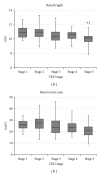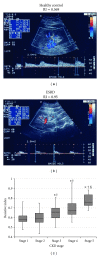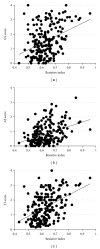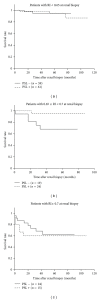The resistive index is a marker of renal function, pathology, prognosis, and responsiveness to steroid therapy in chronic kidney disease patients
- PMID: 23304501
- PMCID: PMC3533455
- DOI: 10.1155/2012/139565
The resistive index is a marker of renal function, pathology, prognosis, and responsiveness to steroid therapy in chronic kidney disease patients
Abstract
To evaluate the significance of the renal resistive index (RI) as a noninvasive marker of renal histological damage and a prognostic indicator, we examined RI by Doppler ultrasonography in 202 chronic kidney disease (CKD) patients who underwent renal biopsy. RI increased as the CKD stage progressed and correlated with age, systolic blood pressure, estimated glomerular filtration rate (eGFR), and renal histological changes, including glomerulosclerosis, arteriolosclerosis, and tubulointerstitial damage. Prognostic evaluation with a median follow-up period of 38.5 months revealed that patients with RI ≥ 0.7 (high RI group, n = 39) had significantly poorer renal survival than those with RI < 0.65 (normal RI group, n = 120) and 0.65 ≤ RI < 0.7 (high-normal RI group, n = 43). The patients in the high-normal RI group showed good response to steroids. However, in the high RI group, steroid therapy did not significantly improve renal survival. Of the clinical indices studied, RI ≥ 0.7, hypertension, proteinuria, and low eGFR at diagnosis were independent risk factors for worsening renal dysfunction. In conclusion, RI in CKD patients was considered as a marker of renal function, histological damage, and renal prognosis, and a possible determinant of indication for steroids.
Figures






Similar articles
-
Usefulness of the resistive index in renal Doppler ultrasonography as an indicator of vascular damage in patients with risks of atherosclerosis.Nephrol Dial Transplant. 2011 Oct;26(10):3256-62. doi: 10.1093/ndt/gfr054. Epub 2011 Mar 3. Nephrol Dial Transplant. 2011. PMID: 21372256
-
Resistive index predicts renal prognosis in chronic kidney disease: results of a 4-year follow-up.Clin Exp Nephrol. 2011 Feb;15(1):114-20. doi: 10.1007/s10157-010-0371-3. Epub 2010 Nov 11. Clin Exp Nephrol. 2011. PMID: 21069409
-
Renal arterial resistive index is associated with severe histological changes and poor renal outcome during chronic kidney disease.BMC Nephrol. 2012 Oct 25;13:139. doi: 10.1186/1471-2369-13-139. BMC Nephrol. 2012. PMID: 23098365 Free PMC article.
-
Resistive index predicts renal prognosis in chronic kidney disease.Nephrol Dial Transplant. 2009 Sep;24(9):2780-5. doi: 10.1093/ndt/gfp121. Epub 2009 Mar 23. Nephrol Dial Transplant. 2009. PMID: 19318356
-
Doppler ultrasound in kidney diseases: a key parameter in clinical long-term follow-up.J Ultrasound. 2016 Apr 16;19(4):243-250. doi: 10.1007/s40477-016-0201-x. eCollection 2016 Dec. J Ultrasound. 2016. PMID: 27965714 Free PMC article. Review.
Cited by
-
Longitudinal changes in blood pressure are preceded by changes in albuminuria and accelerated by increasing dietary sodium intake.Exp Gerontol. 2023 Mar;173:112114. doi: 10.1016/j.exger.2023.112114. Epub 2023 Feb 6. Exp Gerontol. 2023. PMID: 36738979 Free PMC article. Review.
-
Ultrasonographic measurement of the renal resistive index in the cynomolgus monkey (Macaca fascicularis) under conscious and ketamine-immobilized conditions.Exp Anim. 2020 Jan 29;69(1):119-126. doi: 10.1538/expanim.19-0084. Epub 2019 Oct 22. Exp Anim. 2020. PMID: 31645524 Free PMC article.
-
Kidney tissue elastography and interstitial fibrosis observed in kidney biopsy.Ren Fail. 2022 Dec;44(1):314-319. doi: 10.1080/0886022X.2022.2035763. Ren Fail. 2022. PMID: 35166179 Free PMC article.
-
Glucosidase inhibitor, Nimbidiol ameliorates renal fibrosis and dysfunction in type-1 diabetes.Sci Rep. 2022 Dec 15;12(1):21707. doi: 10.1038/s41598-022-25848-1. Sci Rep. 2022. PMID: 36522378 Free PMC article.
-
Correlation of Doppler parameters with renal pathology: A study of 992 patients.Exp Ther Med. 2014 Feb;7(2):439-442. doi: 10.3892/etm.2013.1442. Epub 2013 Dec 10. Exp Ther Med. 2014. PMID: 24396421 Free PMC article.
References
-
- Rifkin MD, Needleman L, Pasto ME. Evaluation of renal transplant rejection by Duplex Doppler examination: value of the resistive index. American Journal of Roentgenology . 1987;148(4):759–762. - PubMed
-
- Platt JF, Rubin JM, Ellis JH, DiPietro MA. Duplex Doppler US of the kidney: differentiation of obstructive from nonobstructive dilatation. Radiology . 1989;171(2):515–517. - PubMed
-
- Patriquin HB, O’Regan S, Robitaille P, Paltiel H. Hemolytic-uremic syndrome: intrarenal arterial Doppler patterns as a useful guide to therapy. Radiology . 1989;172(3):625–628. - PubMed
-
- Platt JF, Rubin JM, Ellis JH. Lupus nephritis: predictive value of conventional and Doppler US and comparison with serologic and biopsy parameters. Radiology . 1997;203(1):82–86. - PubMed
-
- Aikimbaev KS, Canataroğlu A, Özbek S, Usal A. Renal vascular resistance in progressive systemic sclerosis: evaluation with duplex Doppler ultrasound. Angiology . 2001;52(10):697–701. - PubMed
LinkOut - more resources
Full Text Sources
Medical
Research Materials
Miscellaneous

